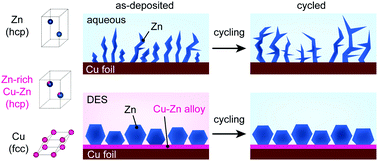Stimulating Cu–Zn alloying for compact Zn metal growth towards high energy aqueous batteries and hybrid supercapacitors†
Abstract
Aqueous Zn-ion batteries (AZIBs) ensure unparalleled safety for large-scale energy storage applications. However, developing highly reversible zinc metal anodes with finite capacity is a prerequisite to realizing the performance characteristics of AZIBs comparable to those of commercial batteries. Herein, we address this issue by identifying the growth mechanism of densely packed micrometer-sized Zn particles on Cu foil to construct a stable anode with a proper Zn loading for AZIBs. Using various characterization techniques, we demonstrate that deep eutectic solvents activate an unusual Cu–Zn alloying reaction to produce a Zn-rich alloy interlayer that is zincophilic and isotypic to the pure Zn phase. This alloy layer, in turn, forms compact Zn deposits of which structure can endure continuous cycling in an aqueous electrolyte, effectively preventing AZIB corrosion and swelling. Owing to the high reversibility of the Zn anode with a Cu–Zn alloy interlayer, the AZIB utilizing more than 25% Zn from the compact anode lasts over 7000 cycles, confirming the possibility of constructing AZIBs with competitive energy densities.



 Please wait while we load your content...
Please wait while we load your content...